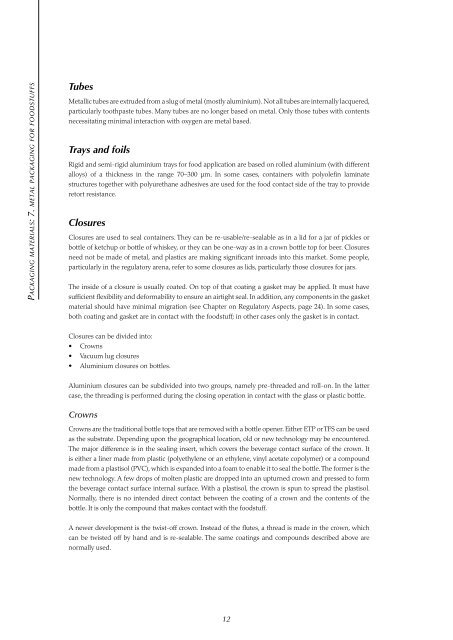packaging materials 7. metal packaging for foodstuffs - Europa
packaging materials 7. metal packaging for foodstuffs - Europa
packaging materials 7. metal packaging for foodstuffs - Europa
Create successful ePaper yourself
Turn your PDF publications into a flip-book with our unique Google optimized e-Paper software.
Pa c k a g i n g ma t e r i a l s: <strong>7.</strong> m e t a l pa c k a g i n g f o r f o o d s t u f f sTubesMetallic tubes are extruded from a slug of <strong>metal</strong> (mostly aluminium). Not all tubes are internally lacquered,particularly toothpaste tubes. Many tubes are no longer based on <strong>metal</strong>. Only those tubes with contentsnecessitating minimal interaction with oxygen are <strong>metal</strong> based.Trays and foilsRigid and semi-rigid aluminium trays <strong>for</strong> food application are based on rolled aluminium (with differentalloys) of a thickness in the range 70–300 μm. In some cases, containers with polyolefin laminatestructures together with polyurethane adhesives are used <strong>for</strong> the food contact side of the tray to provideretort resistance.ClosuresClosures are used to seal containers. They can be re-usable/re-sealable as in a lid <strong>for</strong> a jar of pickles orbottle of ketchup or bottle of whiskey, or they can be one-way as in a crown bottle top <strong>for</strong> beer. Closuresneed not be made of <strong>metal</strong>, and plastics are making significant inroads into this market. Some people,particularly in the regulatory arena, refer to some closures as lids, particularly those closures <strong>for</strong> jars.The inside of a closure is usually coated. On top of that coating a gasket may be applied. It must havesufficient flexibility and de<strong>for</strong>mability to ensure an airtight seal. In addition, any components in the gasketmaterial should have minimal migration (see Chapter on Regulatory Aspects, page 24). In some cases,both coating and gasket are in contact with the foodstuff; in other cases only the gasket is in contact.Closures can be divided into:• Crowns• Vacuum lug closures• Aluminium closures on bottles.Aluminium closures can be subdivided into two groups, namely pre-threaded and roll-on. In the lattercase, the threading is per<strong>for</strong>med during the closing operation in contact with the glass or plastic bottle.CrownsCrowns are the traditional bottle tops that are removed with a bottle opener. Either ETP or TFS can be usedas the substrate. Depending upon the geographical location, old or new technology may be encountered.The major difference is in the sealing insert, which covers the beverage contact surface of the crown. Itis either a liner made from plastic (polyethylene or an ethylene, vinyl acetate copolymer) or a compoundmade from a plastisol (PVC), which is expanded into a foam to enable it to seal the bottle. The <strong>for</strong>mer is thenew technology. A few drops of molten plastic are dropped into an upturned crown and pressed to <strong>for</strong>mthe beverage contact surface internal surface. With a plastisol, the crown is spun to spread the plastisol.Normally, there is no intended direct contact between the coating of a crown and the contents of thebottle. It is only the compound that makes contact with the foodstuff.A newer development is the twist-off crown. Instead of the flutes, a thread is made in the crown, whichcan be twisted off by hand and is re-sealable. The same coatings and compounds described above arenormally used.12

















